February sees the celebration of the Feast of St. Valentine, often represented by pink and red hearts, a burst of greeting cards, and sweet treats. But perhaps the best starting place for finding love is inside ourselves, where that feeling is sure to be noticeable and have a ripple effect in the world around us. Here, we celebrate love in myriad ways.
Ages 4–8
Love Monster and the Scary Something. Rachel Bright. 2016. Farrar, Straus and Giroux.
 In the fourth title featuring her signature solar etchings and the adorably fetching Love Monster, this author-illustrator from England shares a story of love found amid fear. Ready for a sound sleep, Love Monster is frightened because of the terrible “crunch-crunch-crunchety-crunch” sounds he hears after heading for bed, and he imagines fierce creatures on the way to his room. Eventually, Love Monster can’t stand not knowing what is out there hiding in the dark, and he shines a flashlight on his fears. As it turns out, someone else is sleepless and nervous about being all alone. Two new friends cuddle up and face the unknown together. This is a perfect read-aloud to chase fears away. Love Monster will surely steal every reader’s heart while still leaving room for the not-so-scary Scary Something, who slips into his bed as well.
In the fourth title featuring her signature solar etchings and the adorably fetching Love Monster, this author-illustrator from England shares a story of love found amid fear. Ready for a sound sleep, Love Monster is frightened because of the terrible “crunch-crunch-crunchety-crunch” sounds he hears after heading for bed, and he imagines fierce creatures on the way to his room. Eventually, Love Monster can’t stand not knowing what is out there hiding in the dark, and he shines a flashlight on his fears. As it turns out, someone else is sleepless and nervous about being all alone. Two new friends cuddle up and face the unknown together. This is a perfect read-aloud to chase fears away. Love Monster will surely steal every reader’s heart while still leaving room for the not-so-scary Scary Something, who slips into his bed as well.
Samson in the Snow. Philip C. Stead. 2016. Roaring Brook.
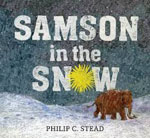 A tender story of a most unlikely friendship and how love can bloom in the most unexpected places and in the worst kind of weather is complemented by lovely illustrations rendered with oil pastels, charcoal, and cardboard printing. As he rests in a field, Samson, a woolly mammoth, watches a friendly red bird gather yellow dandelions for a special friend. Although their encounter is brief, Samson worries about the bird when snow starts to fall. When he looks for her, Samson stumbles upon a mouse almost buried in the snow, and together they continue the search. Thanks to the bright flowers the bird plucked earlier for her friend, they spot her. Had it not been for that red bird’s initial friendly gesture to Samson—or the love that prompted her to gather a bouquet—she most likely would have escaped his notice and perished in the snow.
A tender story of a most unlikely friendship and how love can bloom in the most unexpected places and in the worst kind of weather is complemented by lovely illustrations rendered with oil pastels, charcoal, and cardboard printing. As he rests in a field, Samson, a woolly mammoth, watches a friendly red bird gather yellow dandelions for a special friend. Although their encounter is brief, Samson worries about the bird when snow starts to fall. When he looks for her, Samson stumbles upon a mouse almost buried in the snow, and together they continue the search. Thanks to the bright flowers the bird plucked earlier for her friend, they spot her. Had it not been for that red bird’s initial friendly gesture to Samson—or the love that prompted her to gather a bouquet—she most likely would have escaped his notice and perished in the snow.
Ages 9–11
Everyone Loves Cupcake. Kelly DiPucchio. Ill. Eric Wight. 2016. Farrar, Straus and Giroux.
 In the same stylish fashion in which this creative duo delivered Everyone Loves Bacon (2015), this picture book explores the dark side of the seemingly irrepressible Cupcake. Although everyone seems to love Cupcake, her focus on perfection becomes annoying, and several of the other baked goods get tired of her. Eventually, she confesses her honest feelings about birthday parties and the true nature of her frosting. Honesty about her imperfections encourages the others to share their feelings as well, setting up an oh-so-sweet ending. The digital illustrations are filled with yummy depictions of food, and several of the food-related lines are clever: a loaf of bread blames being “an early riser” for its reluctance to spend time with Cupcake, and a tea bag demurs because it has to “take a bath.” Readers should take care when reading this book because its images and descriptions are likely to send them scavenging for their own sweet treats, possibly even a chocolate cupcake with sprinkles that has plenty of love to go around.
In the same stylish fashion in which this creative duo delivered Everyone Loves Bacon (2015), this picture book explores the dark side of the seemingly irrepressible Cupcake. Although everyone seems to love Cupcake, her focus on perfection becomes annoying, and several of the other baked goods get tired of her. Eventually, she confesses her honest feelings about birthday parties and the true nature of her frosting. Honesty about her imperfections encourages the others to share their feelings as well, setting up an oh-so-sweet ending. The digital illustrations are filled with yummy depictions of food, and several of the food-related lines are clever: a loaf of bread blames being “an early riser” for its reluctance to spend time with Cupcake, and a tea bag demurs because it has to “take a bath.” Readers should take care when reading this book because its images and descriptions are likely to send them scavenging for their own sweet treats, possibly even a chocolate cupcake with sprinkles that has plenty of love to go around.
The Rat Prince. Bridget Hodder. 2016. Farrar, Straus and Giroux.
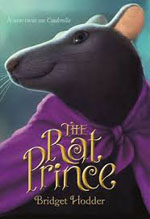 Told in alternating chapters by Prince Char, a royal rat, and the human he has grown to love, Cinderella or Rose de Lancastyr, a beautiful girl whose feeble-minded father’s remarriage to a cruel woman bent on bleeding him dry reduces her to a servant state, this Cinderella story with a twist features extreme cruelty and greed, leavened by acts of kindness. When the father of the prince of the kingdom hosts a ball for the prince to find a marriageable woman, Cinderella regards the ball as a possible chance to reach out to her father’s friends and persuade them to help him get away from his new wife. But Cinderella may be in danger from deranged, violent Prince Geoffrey. Although it might be odd to conceive of a girl and a rat falling in love, the two had bonded long before Cinderella had any idea Prince Char was royalty. In the end, Geoffrey is less princely than Cinderella’s rat friend.
Told in alternating chapters by Prince Char, a royal rat, and the human he has grown to love, Cinderella or Rose de Lancastyr, a beautiful girl whose feeble-minded father’s remarriage to a cruel woman bent on bleeding him dry reduces her to a servant state, this Cinderella story with a twist features extreme cruelty and greed, leavened by acts of kindness. When the father of the prince of the kingdom hosts a ball for the prince to find a marriageable woman, Cinderella regards the ball as a possible chance to reach out to her father’s friends and persuade them to help him get away from his new wife. But Cinderella may be in danger from deranged, violent Prince Geoffrey. Although it might be odd to conceive of a girl and a rat falling in love, the two had bonded long before Cinderella had any idea Prince Char was royalty. In the end, Geoffrey is less princely than Cinderella’s rat friend.
The Warden’s Daughter. Jerry Spinelli. 2017. Alfred A. Knopf/Random House.
 Twelve-year-old Cammie O’Reilly loves the notoriety that comes her way due to her proximity to the inmates of Two Mills, Pennsylvania’s Hancock County Prison, where she lives in an apartment with her father, the warden. Cammie is something of a pistol, though, engaged in a desperate search for someone who can love her like her own mother, who died saving Cammie’s life when she was a baby. Her quest for a mother sends Cammie in self-destructive directions and causes her to be blind to her father’s love and the affection of many of the inmates, especially Eloda Pupko, the trustee caregiver who keeps an eye on her. In his sure-handed way, blending pathos and humor, Spinelli weaves an enticing story that shows how an unexpected love saves one girl with a broken heart.
Twelve-year-old Cammie O’Reilly loves the notoriety that comes her way due to her proximity to the inmates of Two Mills, Pennsylvania’s Hancock County Prison, where she lives in an apartment with her father, the warden. Cammie is something of a pistol, though, engaged in a desperate search for someone who can love her like her own mother, who died saving Cammie’s life when she was a baby. Her quest for a mother sends Cammie in self-destructive directions and causes her to be blind to her father’s love and the affection of many of the inmates, especially Eloda Pupko, the trustee caregiver who keeps an eye on her. In his sure-handed way, blending pathos and humor, Spinelli weaves an enticing story that shows how an unexpected love saves one girl with a broken heart.
Ages 12–14
100 Days. Nicole McInnes. 2016. Farrar, Straus and Giroux.
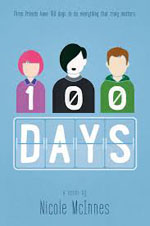 Fifteen-year-old Agnes has progeria, a disease that speeds up the aging process in her body, and as her final 100 days wind down, life is viewed through the lenses of Agnes and two friends: Moira, Agnes’s best friend and protector, and Boone, who has been forced to shoulder much more responsibility than one teen should ever have to face. Because the book alternates these three perspectives, readers learn the characters’ personal secrets as well as their turbulent history together, which at times led to mistrust instead of friendship. Through the poignant stories of these three teens, the author raises questions about friendship, taking risks, and living life to the fullest. Although Agnes realizes that she will never grow up and experience romance, she desperately wants her companions to fall in love with each other while also knowing that they both love her as well.
Fifteen-year-old Agnes has progeria, a disease that speeds up the aging process in her body, and as her final 100 days wind down, life is viewed through the lenses of Agnes and two friends: Moira, Agnes’s best friend and protector, and Boone, who has been forced to shoulder much more responsibility than one teen should ever have to face. Because the book alternates these three perspectives, readers learn the characters’ personal secrets as well as their turbulent history together, which at times led to mistrust instead of friendship. Through the poignant stories of these three teens, the author raises questions about friendship, taking risks, and living life to the fullest. Although Agnes realizes that she will never grow up and experience romance, she desperately wants her companions to fall in love with each other while also knowing that they both love her as well.
Lucky Strikes. Louis Bayard. 2016. Henry Holt.
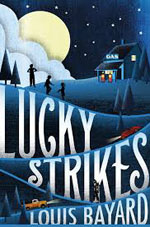 Fourteen-year-old Amelia Hoyle comes up with a desperate plan to keep her family together after her mother, Brenda, dies during the Great Depression. She and her two siblings are living in a little house with a gas station in Walnut Ridge, Virginia, when a vagabond named Hiram Watts literally rolls off a truck and Amelia pretends he is her father. Readers’ hearts will ache for all the responsibilities this young woman must bear, the deceitfulness of her enemy, Blevins, and the lengths to which Blevins is willing to go to have what he wants. When it looks as though all is lost, it turns out that the townspeople have big hearts and more love for Amelia and the memory of her mother than she could ever have imagined, and they save the day. Readers will be reminded that family and love come in different shapes and sizes that may have nothing to do with being related.
Fourteen-year-old Amelia Hoyle comes up with a desperate plan to keep her family together after her mother, Brenda, dies during the Great Depression. She and her two siblings are living in a little house with a gas station in Walnut Ridge, Virginia, when a vagabond named Hiram Watts literally rolls off a truck and Amelia pretends he is her father. Readers’ hearts will ache for all the responsibilities this young woman must bear, the deceitfulness of her enemy, Blevins, and the lengths to which Blevins is willing to go to have what he wants. When it looks as though all is lost, it turns out that the townspeople have big hearts and more love for Amelia and the memory of her mother than she could ever have imagined, and they save the day. Readers will be reminded that family and love come in different shapes and sizes that may have nothing to do with being related.
The Secret Diary of Lydia Bennet. Natasha Farrant. 2016. Chicken House/Scholastic.
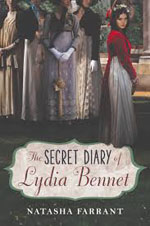 Fans of Jane Austen’s Pride and Prejudice will be thoroughly amused by this book, which gives youngest sister Lydia’s version of the story. Readers will still encounter all the familiar characters and events from the classic, but Lydia so obviously longs to be out from under the control of her older sisters, even as she admires their grace and beauty. Farrant remains faithful to the original story, offering an explanation for how Wickham, the attractive villain who is determined to marry an heiress, and Lydia end up together. Lydia is refreshingly honest and open—and incredibly naïve about Wickham and affairs of the heart. The diary format enables readers to see inside Lydia’s head and smile at her foolishness. Although love comes to Lydia in a very different form than she expected, it comes.
Fans of Jane Austen’s Pride and Prejudice will be thoroughly amused by this book, which gives youngest sister Lydia’s version of the story. Readers will still encounter all the familiar characters and events from the classic, but Lydia so obviously longs to be out from under the control of her older sisters, even as she admires their grace and beauty. Farrant remains faithful to the original story, offering an explanation for how Wickham, the attractive villain who is determined to marry an heiress, and Lydia end up together. Lydia is refreshingly honest and open—and incredibly naïve about Wickham and affairs of the heart. The diary format enables readers to see inside Lydia’s head and smile at her foolishness. Although love comes to Lydia in a very different form than she expected, it comes.
Ages 15+
Because of the Sun. Jenny Torres Sanchez. 2017. Delacorte/Random House.
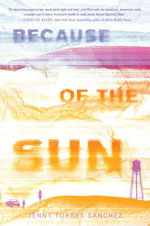 After her mother is mauled to death by a bear in the backyard of their suburban Florida home, Dani Falls moves to New Mexico to live with Shelly, her maternal aunt, a woman she hadn’t even known existed. As she deals with the past that continues to haunt her and tries to make sense of her unsatisfactory relationship with her mother, Dani basks in the desert heat, reads Albert Camus’s The Stranger, and finds acceptance by opening herself up to others, including a young man who is coping with his own losses.
After her mother is mauled to death by a bear in the backyard of their suburban Florida home, Dani Falls moves to New Mexico to live with Shelly, her maternal aunt, a woman she hadn’t even known existed. As she deals with the past that continues to haunt her and tries to make sense of her unsatisfactory relationship with her mother, Dani basks in the desert heat, reads Albert Camus’s The Stranger, and finds acceptance by opening herself up to others, including a young man who is coping with his own losses.
It’s Not Me, It’s You. Stephanie Kate Strohm. 2016. Point/Scholastic.
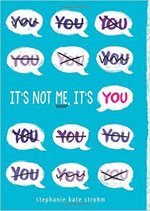 When popular senior Avery Dennis is dumped by her boyfriend right before the school prom in San Anselmo, California, she is understandably shocked. But, being a take-charge young woman, she examines her life and dating history for clues as to why this happened and ends up submitting her findings as a lengthy oral history project for her grade in an American history class. Through the observations of her best friend, Coco Kim, and comments from other friends, foes, and scorned boyfriends, Avery presses on to uncover why so many of her romantic entanglements have ended. Her lab partner, James “Hutch” Hutchinson, also helps her mine the data she’s collecting. Because the book is told in a series of interviews, readers must sort out facts from fallacies, but it’s clear from the start that Avery had overlooked someone who’s had her back all along. It is neat to have some perspective on Avery’s actions from those who know her best (or think they do), including some of her romantic victims. Watching Hutch get more upset and protective as the project unfolds is particularly entertaining. This might be the perfect book to read for Valentine’s Day because it demonstrates that true love does find a way—even if it takes four years for the couple to realize that they are perfect for each other.
When popular senior Avery Dennis is dumped by her boyfriend right before the school prom in San Anselmo, California, she is understandably shocked. But, being a take-charge young woman, she examines her life and dating history for clues as to why this happened and ends up submitting her findings as a lengthy oral history project for her grade in an American history class. Through the observations of her best friend, Coco Kim, and comments from other friends, foes, and scorned boyfriends, Avery presses on to uncover why so many of her romantic entanglements have ended. Her lab partner, James “Hutch” Hutchinson, also helps her mine the data she’s collecting. Because the book is told in a series of interviews, readers must sort out facts from fallacies, but it’s clear from the start that Avery had overlooked someone who’s had her back all along. It is neat to have some perspective on Avery’s actions from those who know her best (or think they do), including some of her romantic victims. Watching Hutch get more upset and protective as the project unfolds is particularly entertaining. This might be the perfect book to read for Valentine’s Day because it demonstrates that true love does find a way—even if it takes four years for the couple to realize that they are perfect for each other.
Barbara A. Ward teaches graduate and undergraduate courses in literacy at Washington State University, Pullman. She spent 25 years teaching in the public schools of New Orleans, where she worked with students at every grade level, from kindergarten through high school, as well as several ability levels. She is certified in elementary education, English education, and gifted education. She holds a bachelor's degree in Communications, a master's degree in English Education from the University of Tennessee, and a PhD in Curriculum and Instruction from the University of New Orleans.
These reviews are submitted by members of the International Literacy Association's Children's Literature and Reading Special Interest Group (CL/R SIG) and are published weekly on Literacy Daily.